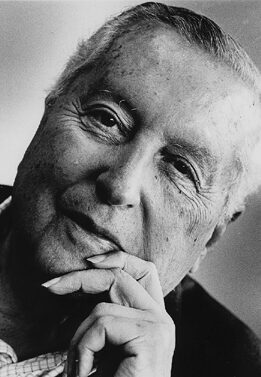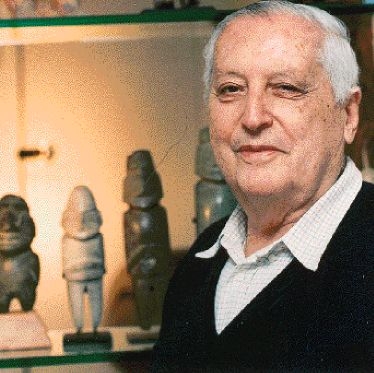<Back to Index>
- Chemist Ilya Romanovich Prigozhin, 1917
- Author Adeline Virginia Woolf, 1882
- General Charles François du Périer Dumouriez, 1739
PAGE SPONSOR



Ilya, Viscount Prigogine (Russian: Илья́ Рома́нович Приго́жин, Ilya Romanovich Prigozhin) (25 January 1917 – 28 May 2003) was a Russian born naturalized Belgian physical chemist and Nobel Laureate noted for his work on dissipative structures, complex systems, and irreversibility.
Prigogine was born in Moscow a few months before the Russian Revolution of 1917. His father, Roman (Ruvim Abramovich) Prigogine, was a chemical engineer at the Moscow Institute of Technology; his mother, Yulia Vikhman, was a pianist. Because the family was critical of the new Soviet system, they left Russia in 1921. They first went to Germany and in 1929, to Belgium, where Prigogine received Belgian citizenship in 1949.
Prigogine studied chemistry at the Free University of Brussels, where in 1950, he became professor. In 1959, he was appointed director of the International Solvay Institute in Brussels, Belgium. In that year, he also started teaching at the University of Texas at Austin in the United States, where he later was appointed Regental Professor and Ashbel Smith Professor of Physics and Chemical Engineering. From 1961 until1966 he was affiliated with the Enrico Fermi Institute at the University of Chicago. In Austin, in 1967, he co-founded what is now called The Center for Complex Quantum Systems. In that year, he also returned to Belgium, where he became director of the Center for Statistical Mechanics and Thermodynamics.
He was a member of numerous scientific organizations, and received numerous awards, prizes and 53 honorary degrees. In 1955, Ilya Prigogine was awarded the Francqui Prize for Exact Sciences. For his study in irreversible thermodynamics, he received the Rumford Medal in 1976, and in 1977, the Nobel Prize in Chemistry. In 1989, he was awarded the title of Viscount by the King of the Belgians. Until his death, he was president of the International Academy of Science and was in 1997, one of the founders of the International Commission on Distance Education (CODE), a worldwide accreditation agency.
Prigogine was married to Polish born chemist Maryna Prokopowicz(-Prigogine) in 1961. They have two sons.
Prigogine is best known for his definition of dissipative structures and their role in thermodynamic systems far from equilibrium, a discovery that won him the Nobel Prize in Chemistry in 1977. Dissipative structure theory led to pioneering research in self organizing systems,
as well as philosophical inquiries into the formation of complexity on
biological entities and the quest for a creative and irreversible role
of time in the natural sciences. His work is seen by many as a bridge between natural sciences and social sciences. With professor Robert Herman, he also developed the basis of the two fluid model, a traffic model in traffic engineering for urban networks, in parallel to the two fluid model in Classical Statistical Mechanics.
In his later years, his work concentrated on the mathematical role of determinism in nonlinear systems on both the classical and quantum level. He proposed the use of a rigged Hilbert space in
quantum mechanics as one possible method of achieving irreversibility in quantum systems. He also co-authored several books with Isabelle Stengers, including End of Certainty and the well known La Nouvelle Alliance (The New Alliance).
In his 1997 book, The End of Certainty, Prigogine contends that determinism is no longer a viable scientific belief. "The more we know about our universe, the more difficult it becomes to believe in determinism." This is a major departure from the approach of Newton, Einstein and Schrödinger, all of whom expressed their theories in terms of deterministic equations. According to Prigogine, determinism loses its explanatory power in the face of irreversibility and instability. Prigogine traces the dispute over determinism back to Darwin, whose attempt to explain individual variability according to evolving populations inspired Ludwig Boltzmann to explain the behavior of gases in terms of populations of particles rather than individual particles. This led to the field of statistical mechanics and the realization that gases undergo irreversible processes. In deterministic physics, all processes are time reversible, meaning that they can proceed backward as well as forward through time. As Prigogine explains, determinism is fundamentally a denial of the arrow of time. With no arrow of time, there is no longer a privileged moment known as the "present," which follows a determined "past" and precedes an undetermined "future." All of time is simply given, with the future as determined or undetermined as the past. With irreversibility, the arrow of time is reintroduced to physics. Prigogine notes numerous examples of irreversibility, including diffusion, radioactive decay, solar radiation, weather and the emergence and evolution of life. Like weather systems, organisms are unstable systems existing far from thermodynamic equilibrium. Instability resists standard deterministic explanation. Instead, due to sensitivity to initial conditions, unstable systems can only be explained statistically, that is, in terms of probability.
Prigogine asserts that Newtonian physics has now been "extended" three times, first with the use of the wave function in quantum mechanics, then with the introduction of spacetime in general relativity and finally with the recognition of indeterminism in the study of unstable systems.